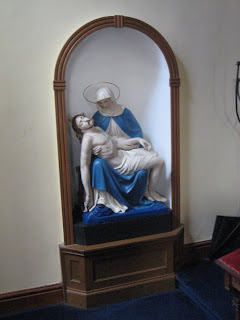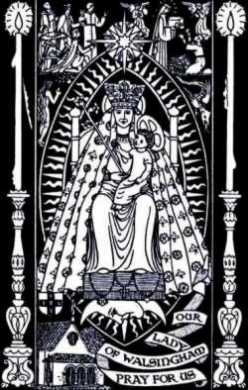The west end.
St Raphael, who should be patron of the Anglican Communion.
 In the graveyard.
In the graveyard.The Church from the West end.
Font.
The body of the Church.
 Ambo and Lady Chapel screen.
Ambo and Lady Chapel screen.Sanctuary.
 Oil house in the font top.
Oil house in the font top.High Altar.
Lady Chapel altar.
Mensa of the Lady Chapel altar.
 Saint Benedict.
Saint Benedict.After lunch on Sunday, I was driving towards Hoghton Tower (more of that later) and I saw a sign pointing to 'St Joseph's RC Church'. Knowing this area to be full of pre-emancipation act Chapels, I took the back lane and followed it for a while before seeing a very unprepossessing Parish Hall and a smaller yet lane leading to this gem of a Church. It is a Benedictine foundation and still cared for by them. The Mother House is Ampleforth Abbey and there is once again to be a Parish Priest for the Church, although resident at the house in Bamber Bridge, near Preston. This seems a shame because it means the little Priory building will be empty and, as I was shown, it could do with being looked after and lived in. We entered through the sacristy where the remains of a chasuble used by St John Southworth, one of the forty martyrs of England and Wales is kept.
The sacristy leads into the sanctuary and two things immediately strike you. First, the translucent quality of the marble in the High Altar and secondly the comparative plainness of the body of the Church. The High Altar is stunning, showing St Peter atop, the death of St Joseph under the mensa and the pious pelican above the tabernacle, which is complete with a hidden monstrance throne. The nave altar is a fine old Jacobean sideboard, plain panelled to the back, with grotesques on the front. An odd choice of altar and there seemed agreement from my kind guide that the eastward altar was the preferable choice.
Leading from the sanctuary is the Lady Chapel. with a very fine altar and screen. The ambo was, I surmised, removed from a wall mounted pulpit and placed here as part of a reordering, but no information was available. There is a most interesting font as well, with a dome containing the holy oils on top, once attached to a chain to winch it up. How it is taken off now I do not know, for it weighs a tonne.
The body of the Church shows it's Georgian age, with typical windows and a plain West end, in line with the Catholic emancipation act regulations. The pews are cast iron chapel pews and were it not for the sanctuary, one could be in a congregationalist Chapel, the effect heightened by the lack of a central aisle. I was told that the existing side aisles were widened not long ago as it was almost impossible to carry coffins with any dignity and the brides entrance at a wedding was peculiar, to say the least.
The Church is busy, I was told, and well loved. My guide seemed to be a great fan of the place, commenting on the four thuribles, that she would see them used more, but it depended which Priest they could find to say the Mass. The fine graveyard is well tended and full of most interesting gravestones, one pictured above. I left remarking on how good it was to find that most remarkable thing, a rural Roman Catholic Church of beauty.


















_Black_s_s_s_s_s.jpg)
